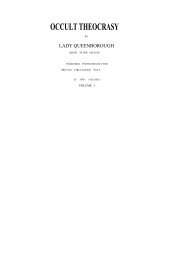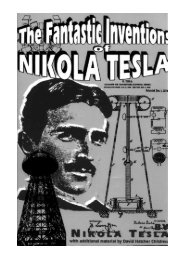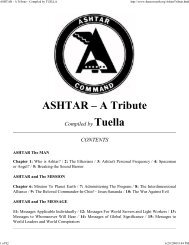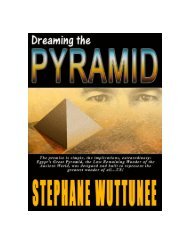the fantastic inventions of nikola tesla - Exopolitics Hong Kong
the fantastic inventions of nikola tesla - Exopolitics Hong Kong
the fantastic inventions of nikola tesla - Exopolitics Hong Kong
Create successful ePaper yourself
Turn your PDF publications into a flip-book with our unique Google optimized e-Paper software.
The Referee: The north side.<br />
The Witness: Towards <strong>the</strong> road, facing <strong>the</strong> road. That compartment was one hundred<br />
by thirty-five feet with a door in <strong>the</strong> middle and it contained I think eight la<strong>the</strong>s.<br />
The Referee: You are speaking now, when you said facing <strong>the</strong> road, that is on <strong>the</strong><br />
south side, <strong>the</strong> travel road or——<br />
The Witness: Facing <strong>the</strong> railroad. It is just close on <strong>the</strong> railroad track, your Honor, this<br />
building. That contained I think eight la<strong>the</strong>s ranging in swing from eight inches to<br />
thirty-two, I believe. Then <strong>the</strong>re was a milling machine and <strong>the</strong>re was a planer, and<br />
shaper, a spliner, a vertical machine for splining. Then <strong>the</strong>re were three drills, one<br />
very large, ano<strong>the</strong>r medium and a third quite small one. Then <strong>the</strong>re were four<br />
motors which operated <strong>the</strong> machinery. Also a grinder and an ordinary grindstone, a<br />
forge——<br />
Q. Blacksmith's forge?<br />
A. Yes, a blacksmith's forge. Then a special high temperature stove and <strong>the</strong> blower for<br />
<strong>the</strong> forge. Of course <strong>the</strong> shop was full <strong>of</strong> counter shafting and <strong>the</strong>re were a few<br />
special tools which suited certain purposes which I contemplated <strong>the</strong>re. I cannot at<br />
present recall <strong>the</strong>m exactly, but <strong>the</strong>re were five or six <strong>of</strong> <strong>the</strong>m.<br />
Q. Were those stationary tools or hand tools?<br />
A. No, -some <strong>of</strong> <strong>the</strong>m were attachments to <strong>the</strong> ordinary la<strong>the</strong>s or milling machines,<br />
suitable for certain work and o<strong>the</strong>rs were <strong>of</strong> course portable.<br />
Q. Now have you described <strong>the</strong> four compartments <strong>of</strong> <strong>the</strong> building?<br />
A. No. Now <strong>the</strong> compartment opposite, that is facing fur<strong>the</strong>r away from <strong>the</strong> railroad,<br />
which also was one hundred feet, <strong>the</strong> whole length <strong>of</strong> <strong>the</strong> building, by about thirtyfive,<br />
<strong>the</strong>re is where <strong>the</strong> real expensive apparatus was located. That contained also<br />
<strong>the</strong> desks and <strong>the</strong> <strong>of</strong>fice accessories. Shall 1 describe now this one?<br />
Q. Yes, describe any stationary fixtures <strong>the</strong>re were in this o<strong>the</strong>r compartment.<br />
A. Well, is machinery a stationary fixture? Q. Yes we call that a stationary fixture. A.<br />
Right along <strong>the</strong> back wall that separated this compartment from <strong>the</strong> rest <strong>of</strong> <strong>the</strong><br />
building <strong>the</strong>re were two special glass cases in which I kept <strong>the</strong> historical apparatus<br />
which was exhibited and described in my lectures and scientific articles. There<br />
were probably at least a thousand bulbs and tubes each <strong>of</strong> which represented a<br />
certain phase <strong>of</strong> scientific development. Then close, beginning with <strong>the</strong>se two glass<br />
cases, <strong>the</strong>re were five large tanks. Four <strong>of</strong> those contained special transformers<br />
according to my design, made by <strong>the</strong> Westinghouse Electric Manufacturing<br />
Company. These were to transform <strong>the</strong> energy for <strong>the</strong> plant. They were about, I<br />
should say, seven feet high and about five by five feet each, and were filled with<br />
special oil which we call transformer oil, to stand an electric tension <strong>of</strong> 60,000<br />
volts. Then besides <strong>the</strong>se four tanks <strong>the</strong>re was ano<strong>the</strong>r similar tank which was for<br />
special purposes, containing a transformer. Then <strong>the</strong>re were two doors, one door<br />
that led to <strong>the</strong> o<strong>the</strong>r compartment and <strong>the</strong> o<strong>the</strong>r one led in <strong>the</strong> closets, and between<br />
those two doors <strong>the</strong>re was a space on which was placed my electric generating<br />
apparatus. This apparatus I used in ray laboratory demonstrations in two<br />
laboratories before, and I had also used it in <strong>the</strong> Colorado experiments where I<br />
erected a wireless plant in 1889. That apparatus was precious because it could flash<br />
a message across <strong>the</strong> Atlantic, and yet it was built in 1894 or 1895. That is a<br />
complicated and very expensive apparatus.<br />
Then beyond <strong>the</strong> door <strong>the</strong>re were again four tanks, big tanks almost <strong>the</strong> same size as









